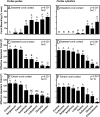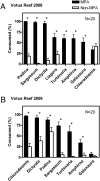Chemically rich seaweeds poison corals when not controlled by herbivores
- PMID: 20457927
- PMCID: PMC2906836
- DOI: 10.1073/pnas.0912095107
Chemically rich seaweeds poison corals when not controlled by herbivores
Abstract
Coral reefs are in dramatic global decline, with seaweeds commonly replacing corals. It is unclear, however, whether seaweeds harm corals directly or colonize opportunistically following their decline and then suppress coral recruitment. In the Caribbean and tropical Pacific, we show that, when protected from herbivores, approximately 40 to 70% of common seaweeds cause bleaching and death of coral tissue when in direct contact. For seaweeds that harmed coral tissues, their lipid-soluble extracts also produced rapid bleaching. Coral bleaching and mortality was limited to areas of direct contact with seaweeds or their extracts. These patterns suggest that allelopathic seaweed-coral interactions can be important on reefs lacking herbivore control of seaweeds, and that these interactions involve lipid-soluble metabolites transferred via direct contact. Seaweeds were rapidly consumed when placed on a Pacific reef protected from fishing but were left intact or consumed at slower rates on an adjacent fished reef, indicating that herbivory will suppress seaweeds and lower frequency of allelopathic damage to corals if reefs retain intact food webs. With continued removal of herbivores from coral reefs, seaweeds are becoming more common. This occurrence will lead to increasing frequency of seaweed-coral contacts, increasing allelopathic suppression of remaining corals, and continuing decline of reef corals.
Conflict of interest statement
The authors declare no conflict of interest.
Figures





Similar articles
-
Seaweed allelopathy degrades the resilience and function of coral reefs.Commun Integr Biol. 2010 Nov;3(6):564-6. doi: 10.4161/cib.3.6.12978. Epub 2010 Nov 1. Commun Integr Biol. 2010. PMID: 21331240 Free PMC article.
-
RETRACTED: Chemically mediated behavior of recruiting corals and fishes: a tipping point that may limit reef recovery.Science. 2014 Aug 22;345(6199):892-7. doi: 10.1126/science.1255057. Epub 2014 Aug 21. Science. 2014. Retraction in: Science. 2022 Aug 19;377(6608):826. doi: 10.1126/science.ade2691. PMID: 25146281 Free PMC article. Retracted.
-
Seaweed-coral interactions: variance in seaweed allelopathy, coral susceptibility, and potential effects on coral resilience.PLoS One. 2014 Jan 22;9(1):e85786. doi: 10.1371/journal.pone.0085786. eCollection 2014. PLoS One. 2014. PMID: 24465707 Free PMC article.
-
Climate change impacts on coral reefs: synergies with local effects, possibilities for acclimation, and management implications.Mar Pollut Bull. 2013 Sep 30;74(2):526-39. doi: 10.1016/j.marpolbul.2013.06.011. Epub 2013 Jun 28. Mar Pollut Bull. 2013. PMID: 23816307 Review.
-
Coral bleaching--capacity for acclimatization and adaptation.Adv Mar Biol. 2003;46:183-223. doi: 10.1016/s0065-2881(03)46004-5. Adv Mar Biol. 2003. PMID: 14601413 Review.
Cited by
-
Testing sea urchin and green sea turtle consumption of the allelopathic macroalga Galaxaura divaricata.Ecol Evol. 2024 Apr 25;14(4):e11324. doi: 10.1002/ece3.11324. eCollection 2024 Apr. Ecol Evol. 2024. PMID: 38681181 Free PMC article.
-
The effect of reef morphology on coral recruitment at multiple spatial scales.Proc Natl Acad Sci U S A. 2024 Jan 23;121(4):e2311661121. doi: 10.1073/pnas.2311661121. Epub 2024 Jan 8. Proc Natl Acad Sci U S A. 2024. PMID: 38190515 Free PMC article.
-
Competitive effects of the macroalga Caulerpa taxifolia on key physiological processes in the scleractinian coral Turbinaria peltata under thermal stress.PeerJ. 2023 Dec 14;11:e16646. doi: 10.7717/peerj.16646. eCollection 2023. PeerJ. 2023. PMID: 38107563 Free PMC article.
-
Comparison of feeding preferences of herbivorous fishes and the sea urchin Diadema antillarum in Little Cayman.PeerJ. 2023 Nov 15;11:e16264. doi: 10.7717/peerj.16264. eCollection 2023. PeerJ. 2023. PMID: 38025680 Free PMC article.
-
Microbiomes and metabolomes of dominant coral reef primary producers illustrate a potential role for immunolipids in marine symbioses.Commun Biol. 2023 Aug 31;6(1):896. doi: 10.1038/s42003-023-05230-1. Commun Biol. 2023. PMID: 37653089 Free PMC article.
References
-
- Done TJ, Ogden JC, Wiebe WJ, Rosen BR. In: Functional Roles of Biodiversity: A Global Perspective. Mooney HA, Cushman HH, Medina E, Sala OE, Schultze ED, editors. New York: Wiley; 1996. pp. 393–429.
-
- Moberg F, Folke C. Ecological goods and services of coral reef ecosystems. Ecol Econ. 1999;29:215–233.
-
- Hughes TP, et al. Climate change, human impacts, and the resilience of coral reefs. Science. 2003;301:929–933. - PubMed
-
- Bellwood DR, Hughes TP, Folke C, Nystrom M. Confronting the coral reef crisis. Nature. 2004;429:827–833. - PubMed
-
- Gardner TA, Cote IM, Gill JA, Grant A, Watkinson AR. Long-term region-wide declines in Caribbean corals. Science. 2003;301:958–960. - PubMed
Publication types
MeSH terms
Grants and funding
LinkOut - more resources
Full Text Sources
Other Literature Sources


